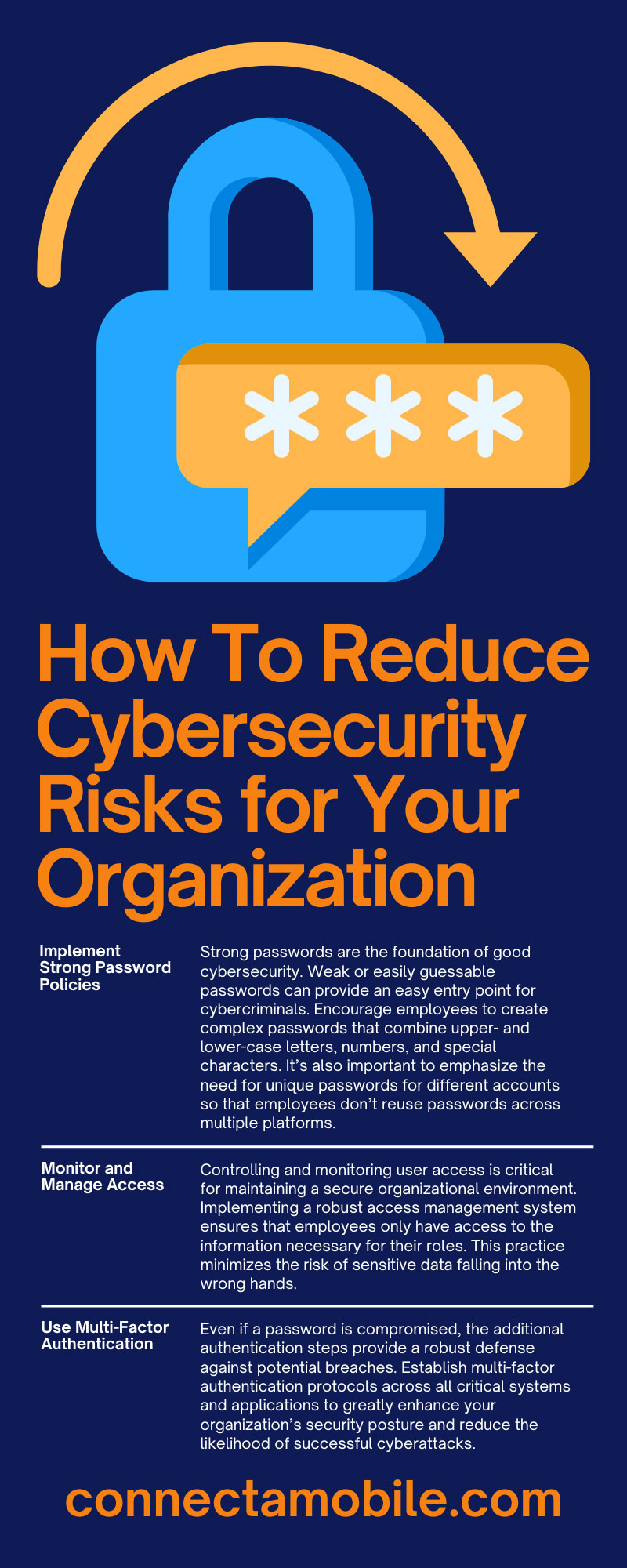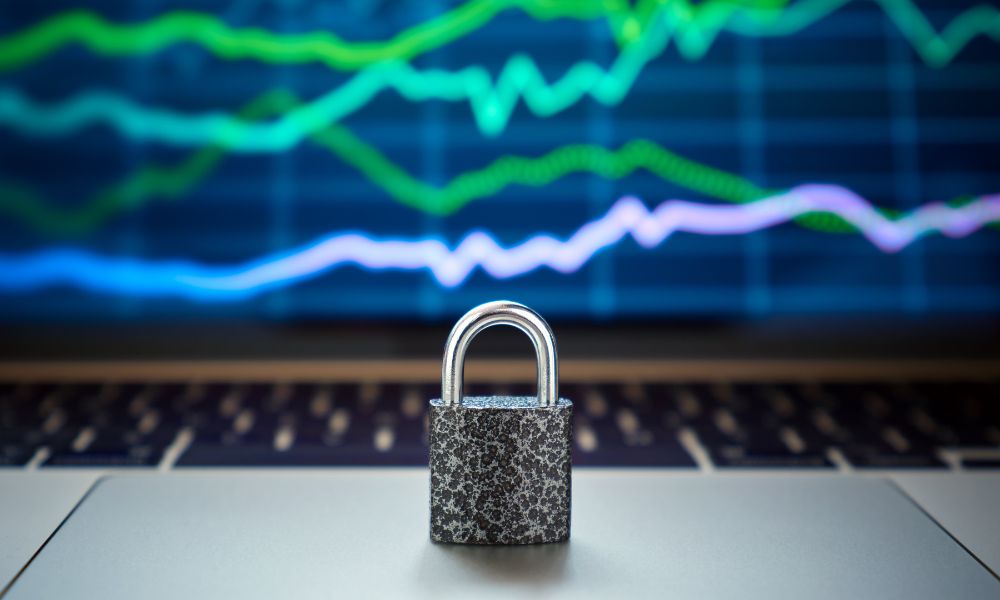With the increasing reliance on technology and internet connectivity, businesses are more vulnerable to cyber threats than ever before. From phishing attacks to malware and ransomware, the array of potential dangers is vast and constantly evolving. It’s crucial for organizations to adopt proactive measures to safeguard their assets, data, and reputation. Read on to explore some of the most effective ways to reduce cybersecurity risks for your organization and protect your employees, customers, and operations.
Implement Strong Password Policies
Strong passwords are the foundation of good cybersecurity. Weak or easily guessable passwords can provide an easy entry point for cybercriminals. Encourage employees to create complex passwords that combine upper- and lower-case letters, numbers, and special characters. It’s also important to emphasize the need for unique passwords for different accounts so that employees don’t reuse passwords across multiple platforms.
Password management tools can be incredibly useful in helping employees generate and store secure passwords without the need for memorization. Regularly updating passwords and conducting audits can also further enhance security and reduce the risk of unauthorized access.
Monitor and Manage Access
Controlling and monitoring user access is critical for maintaining a secure organizational environment. Implementing a robust access management system ensures that employees only have access to the information necessary for their roles. This practice minimizes the risk of sensitive data falling into the wrong hands.
Additionally, regularly reviewing and updating access permissions can prevent former employees or unauthorized individuals from accessing company resources. Effective access management also involves monitoring user activity to detect any unusual or suspicious behavior, which can be an early indicator of a potential security breach.
Use Multi-Factor Authentication
Multi-factor authentication adds an extra layer of security to your organization’s login processes. By requiring users to provide two or more forms of identification—such as a password, a fingerprint, or a code sent to their mobile device—multi-factor authentication makes it significantly harder for unauthorized individuals to access sensitive information.
Even if a password is compromised, the additional authentication steps provide a robust defense against potential breaches. Establish multi-factor authentication protocols across all critical systems and applications to greatly enhance your organization’s security posture and reduce the likelihood of successful cyberattacks.
Conduct Regular Employee Training
Whether it involves weak passwords or accidental clicks on scam emails, human error remains one of the leading causes of security breaches. Luckily, you can minimize these mistakes by prioritizing education and best practices across your organization.
Regular training sessions can help employees recognize phishing emails, avoid clicking on suspicious links, and understand the importance of safeguarding sensitive information. Use hands-on training, such as simulated phishing attacks, to help assess your team’s awareness and preparedness. By investing in continuous training, you ensure that your workforce remains vigilant and informed about the latest threats.
Back Up Data Regularly
One of the simplest yet most effective ways to reduce cybersecurity risks for your organization is to back up your data regularly. This ensures that, in the event of a cyberattack or data breach, you won’t lose critical information.
It’s essential to develop a comprehensive backup strategy that includes daily, weekly, and monthly backups stored in multiple locations, such as cloud storage and physical drives. Automate the backup process to reduce the risk of human error and ensure consistency.
Additionally, test your backup systems regularly to confirm that they are functioning correctly and that you can restore your data when needed. By prioritizing data backups, you’ll have a safety net in place that helps minimize downtime and data loss during a cyber incident.
Protect Remote Workers
With the increasing number of employees working remotely, it’s vital to implement robust security measures to protect your organization’s data. Remote workers often access company accounts, communication platforms, and data through unsecured public networks or personal devices, making them particularly vulnerable to cyberattacks. If you have employees working remotely at any level, it’s crucial to establish and enforce security best practices to protect them and the aspects of your business they interact with.
Start by providing employees with secure virtual private network (VPN) access to encrypt their internet connections and protect sensitive data. Educate your remote workforce about the importance of using strong, unique passwords and multi-factor authentication. Monitor devices with remote management tools, and ensure employees are regularly updating laptops, tablets, and any necessary software to patch any security vulnerabilities.
Update and Patch Regularly
Cybercriminals often exploit known vulnerabilities in outdated software to gain unauthorized access to systems. Regular updates and patches address these vulnerabilities, closing security gaps and strengthening your defenses.
Develop a schedule for updating all software, including operating systems, applications, and security tools. Enable automatic updates whenever possible to ensure timely installations.
Additionally, keep an eye on security advisories and patches released by software vendors so that you can apply them promptly. Share clear communications about any major security rollouts to make sure employees update their devices and accounts as needed. By staying current with updates, you can significantly reduce the risk of cyberattacks and protect your organization’s data.
Create an Incident Response Plan
Preparation is crucial when it comes to cybersecurity. Having a well-defined incident response plan in place allows your organization to react swiftly and effectively to security incidents. Start by identifying potential risks and vulnerabilities specific to your business. Develop a detailed plan outlining the steps to take in the event of a breach, including communication protocols, roles and responsibilities, and recovery procedures.
Conduct regular training sessions with your team to ensure everyone understands their role in the incident response plan. Simulate different scenarios to test the effectiveness of your plan and make necessary adjustments. Having an incident response plan minimizes the impact of a cyberattack and demonstrates to stakeholders that your organization is proactive in protecting its assets.
Invest in a Private Network
Investing in a private cellular network can provide an additional layer of security for your organization. Unlike public networks, private networks offer dedicated bandwidth, reduced latency, and improved security features.
A private network ensures that your communications remain confidential and protected from external threats. It also allows for better control over network access and usage, enabling you to implement stricter security policies and closely monitor all activity. By investing in a private network, you can enhance your organization’s security posture and protect sensitive information from potential breaches.
If you’re looking for secure solutions for your business, let Connecta Mobile help. Equip your organization with a private LTE network and secure cell phones when you work with our team today.

